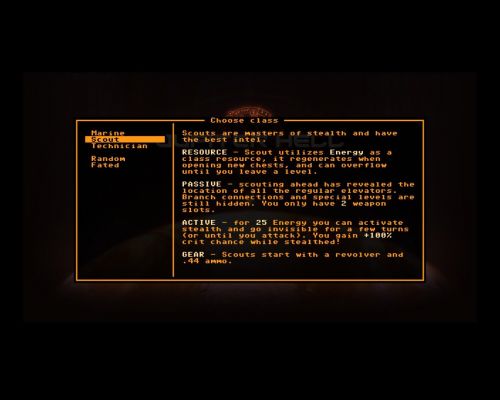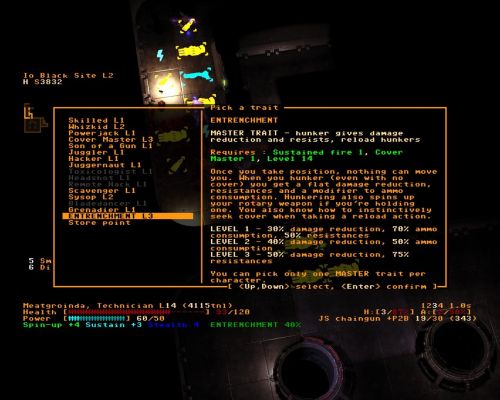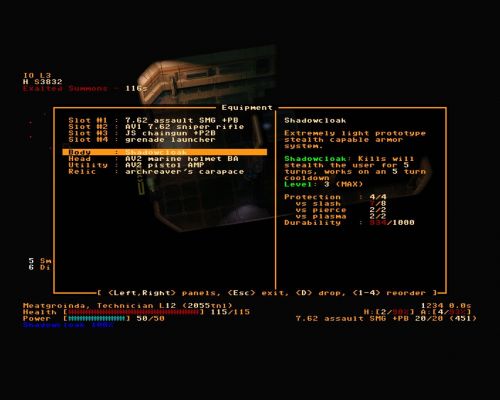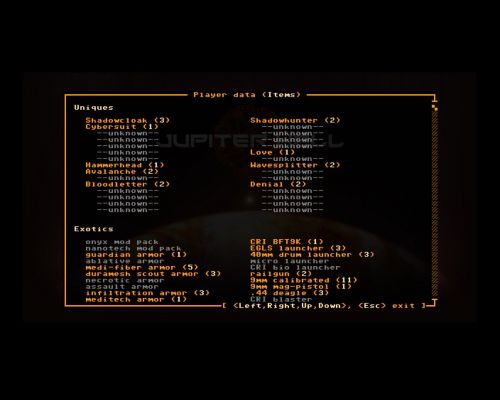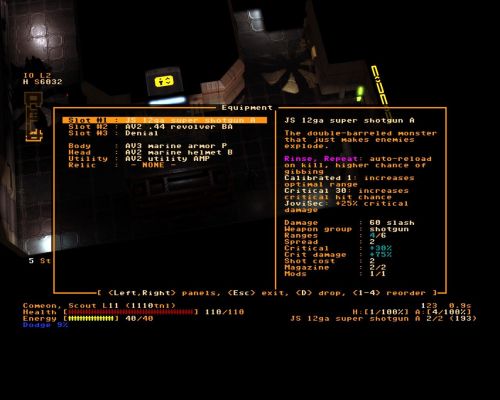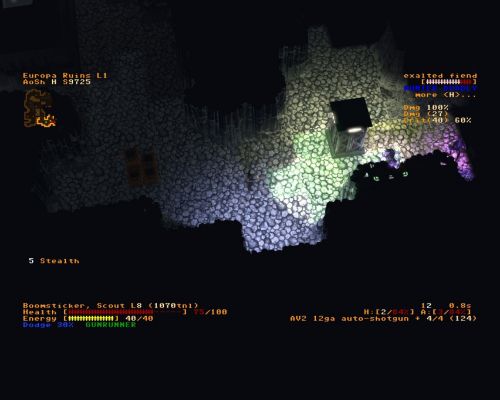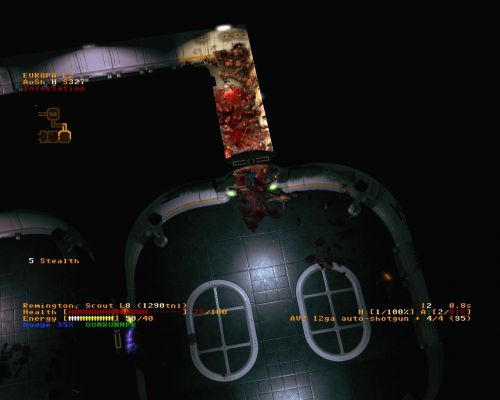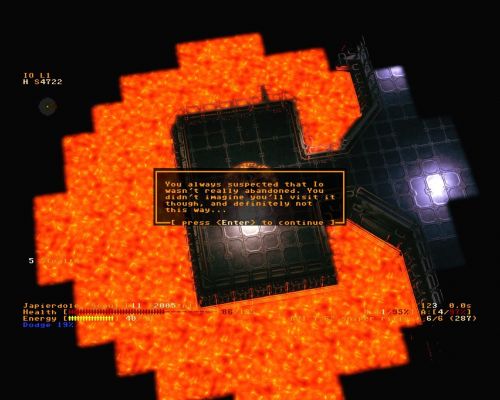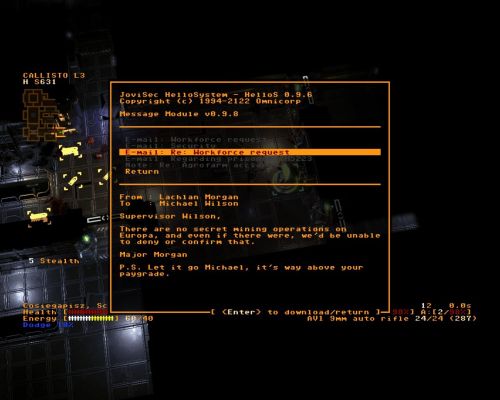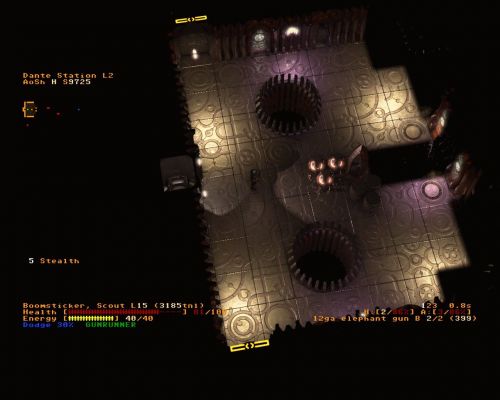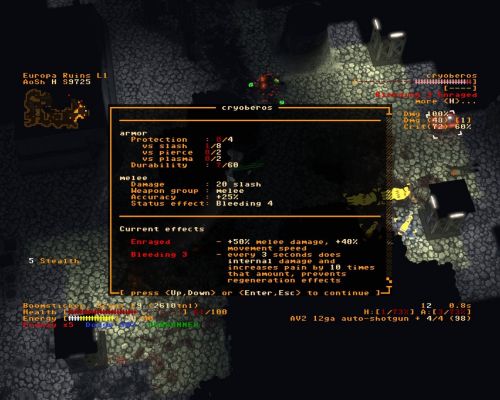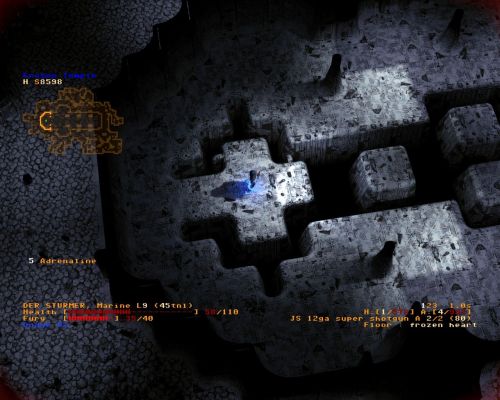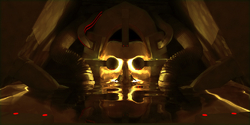RPG Codex Review: Jupiter Hell
RPG Codex Review: Jupiter Hell
Codex Review - posted by Infinitron on Sat 28 May 2022, 15:52:51
Tags: ChaosForge; Jupiter HellRoguelikes have never been a primary focus of this website, nor of our chief content officer Darth Roxor, who in fact has very little experience with the genre. As a fan of Doom, one roguelike he has played extensively is DoomRL, the venerable Doom-based roguelike by Kornel Kisielewicz. So it's no surprise that Kisielewicz's DoomRL successor Jupiter Hell was of great interest to him when it appeared on Kickstarter back in 2016. Having played it extensively even before it left Early Access last August, Roxor has now turned in his review of this title, and his verdict is uniformly positive. Here's his appraisal of the game's core combat mechanics:
Read the full article: RPG Codex Review: Jupiter Hell
At a basic level, combat is very similar to DoomRL. Everything is turn-based, you get one action a turn, and the rest of the world moves together with you. Actions take time to perform, the baseline being ‘1 second’, but some are obviously faster than others. If you have a 50% movement speed boost, you’ll be able to take two steps over the same time as it’ll take most other enemies to take one. Managing the time taken to do things is extremely important, as quickness will often allow you to avoid getting whacked.
Guns have accuracy thresholds for distance, with all having optimal and max ranges, and some having minimum range. You will take an accuracy penalty for being at a distance lower than minimum or greater than optimal, while exceeding max range will down your accuracy to zero. One thing I don’t entirely get here is the purpose of optimal/max ranges greater than 6, because 6 tiles is the limit of your view, and you can’t shoot beyond that, even with blind fire. The only exception are shotguns, which aren’t subject to accuracy, and distance only influences their damage, while spraying blindly into the fog of war can actually hurt enemies beyond the 6-tile limit. It can also be extremely effective if you manage to lay your hands on a long-range shotgun.
Where Jupiter Hell strays from its predecessor is in its inclusion of cover mechanics. Anything between you and your opponent will act as cover – this includes props, walls and other enemies. Shooting something behind cover significantly influences accuracy, which makes positioning in combat a vital factor, especially since a number of perks also have an impact on cover, either by reducing it for your targets, or increasing its effectiveness for you. Thus, hunkering down behind some walls, spinning up your chaingun and using an extra action or two to aim can help you withstand even the most unfavourable odds. Similarly, a stupid zombie grunt with a handgun can become a much bigger nuisance when behind cover.
The maps in Jupiter Hell are generally rather tight as well, with big open rooms being a rarity, so cover is something to always keep in mind as you plan your approach. Plus, even in the bigger rooms you’ll find plenty of props, such as chairs or crates, to provide cover, though these are all destructible.
But that’s not to say that (ab)using cover is the ultimate way to go. It’s obviously going to be much less useful if you’re playing a running man. And even if you’re focused on entrenchment, there’s still plenty of things that can smoke you out, particularly acid pools and poison clouds that can be thrown by various enemies. Plus, no matter how much of a living bunker you are, some attacks will still go through and keep chipping away at your health – cover may be important, but it’s still just an individual mechanic, and not god mode, and Jupiter Hell is fortunately not a cover shooter.
Another thing to keep in mind is pain. As you get damaged, you’ll accumulate pain – some enemies even have special abilities that leave you in pain just by looking at you. Pain is a percentage that reduces your accuracy, so the more you get whacked, the worse your performance becomes. In my experience, this mechanic is primarily there to punish your mistakes – if you’re standing in the open like a dumbass, or you keep shooting at a fiend that’s in your face and slashing you, your pain will ramp up, and well, it’s exactly something you deserve. As mentioned before, the marine can cleanse pain and convert it into healing with his special ability, while other classes will have to either wait it out or use a medkit to remove all pain. Oftentimes, waiting it out in the middle of a slaughterfest is not an option.
One thing that I’ve come to realise is a bit of a bummer is that pain applies only to you. The game is generally fair and symmetrical when it comes to its mechanics, but pain is an exception that can sometimes be annoying when facing enemies with high health pools. With more straight-forward builds, the best thing you can do is take cover behind a corner, keep shooting and pray that none of their attacks go through – it feels a little arbitrary, especially when you reach a ceiling where your damage won’t be getting higher, but you’ll still encounter tougher enemies, which leaves you without some additional way to mitigate the risks.
Nevertheless, playing carefully and managing the risks is an important part of Jupiter Hell, since just like most other roguelikes, it’s extremely unforgiving when it comes to dumb mistakes. I’d say that most of my runs are interrupted by a sudden bout of dying due to losing focus. You keep tapping those movement keys like stupid, you run into an armoured ravager, you get blasted with rockets and die. You can’t be bothered to take a step aside and duck behind cover – that former CRI sergeant will be more than glad to spray you with lead. Even worse if you forget about the stuff you’re carrying, and realise only after dying that you could have teleported to safety with a phase kit or run away in a smokescreen. But you were actually too much of a cheapskate to use them, so quit whining.
Guns have accuracy thresholds for distance, with all having optimal and max ranges, and some having minimum range. You will take an accuracy penalty for being at a distance lower than minimum or greater than optimal, while exceeding max range will down your accuracy to zero. One thing I don’t entirely get here is the purpose of optimal/max ranges greater than 6, because 6 tiles is the limit of your view, and you can’t shoot beyond that, even with blind fire. The only exception are shotguns, which aren’t subject to accuracy, and distance only influences their damage, while spraying blindly into the fog of war can actually hurt enemies beyond the 6-tile limit. It can also be extremely effective if you manage to lay your hands on a long-range shotgun.
Where Jupiter Hell strays from its predecessor is in its inclusion of cover mechanics. Anything between you and your opponent will act as cover – this includes props, walls and other enemies. Shooting something behind cover significantly influences accuracy, which makes positioning in combat a vital factor, especially since a number of perks also have an impact on cover, either by reducing it for your targets, or increasing its effectiveness for you. Thus, hunkering down behind some walls, spinning up your chaingun and using an extra action or two to aim can help you withstand even the most unfavourable odds. Similarly, a stupid zombie grunt with a handgun can become a much bigger nuisance when behind cover.
The maps in Jupiter Hell are generally rather tight as well, with big open rooms being a rarity, so cover is something to always keep in mind as you plan your approach. Plus, even in the bigger rooms you’ll find plenty of props, such as chairs or crates, to provide cover, though these are all destructible.
But that’s not to say that (ab)using cover is the ultimate way to go. It’s obviously going to be much less useful if you’re playing a running man. And even if you’re focused on entrenchment, there’s still plenty of things that can smoke you out, particularly acid pools and poison clouds that can be thrown by various enemies. Plus, no matter how much of a living bunker you are, some attacks will still go through and keep chipping away at your health – cover may be important, but it’s still just an individual mechanic, and not god mode, and Jupiter Hell is fortunately not a cover shooter.
Another thing to keep in mind is pain. As you get damaged, you’ll accumulate pain – some enemies even have special abilities that leave you in pain just by looking at you. Pain is a percentage that reduces your accuracy, so the more you get whacked, the worse your performance becomes. In my experience, this mechanic is primarily there to punish your mistakes – if you’re standing in the open like a dumbass, or you keep shooting at a fiend that’s in your face and slashing you, your pain will ramp up, and well, it’s exactly something you deserve. As mentioned before, the marine can cleanse pain and convert it into healing with his special ability, while other classes will have to either wait it out or use a medkit to remove all pain. Oftentimes, waiting it out in the middle of a slaughterfest is not an option.
One thing that I’ve come to realise is a bit of a bummer is that pain applies only to you. The game is generally fair and symmetrical when it comes to its mechanics, but pain is an exception that can sometimes be annoying when facing enemies with high health pools. With more straight-forward builds, the best thing you can do is take cover behind a corner, keep shooting and pray that none of their attacks go through – it feels a little arbitrary, especially when you reach a ceiling where your damage won’t be getting higher, but you’ll still encounter tougher enemies, which leaves you without some additional way to mitigate the risks.
Nevertheless, playing carefully and managing the risks is an important part of Jupiter Hell, since just like most other roguelikes, it’s extremely unforgiving when it comes to dumb mistakes. I’d say that most of my runs are interrupted by a sudden bout of dying due to losing focus. You keep tapping those movement keys like stupid, you run into an armoured ravager, you get blasted with rockets and die. You can’t be bothered to take a step aside and duck behind cover – that former CRI sergeant will be more than glad to spray you with lead. Even worse if you forget about the stuff you’re carrying, and realise only after dying that you could have teleported to safety with a phase kit or run away in a smokescreen. But you were actually too much of a cheapskate to use them, so quit whining.
Read the full article: RPG Codex Review: Jupiter Hell
[Review by Darth Roxor]
This is going to be one hell of a fight
Jupiter Hell is the successor to the acclaimed Doom, the Roguelike (or, depending on whom you ask, DoomRL; D**m, the Roguelike; or DRL – trademark infringement is a hanging offence these days). Its development followed a successful Kickstarter campaign in 2016, which was started because the Polish fellow who made the original, freeware game, decided he would like to finally earn some potato from it.
Anyhow, everything seemed to point that Jupiter Hell would be little more than DoomRL with a new paint job. This was very much to my liking, because frankly speaking, DoomRL might be the only roguelike that I ever really enjoyed, so having more of it in some new fashion was a very welcome perspective.
After spending some time stewing in early access, it was finally released for real in 2021. Now the time has come to subject it to a critical examination.
Note that, as I said above, DoomRL is my only real experience with roguelikes, so I can’t tell you how Jupiter Hell fits in the genre at large, and most of the comparisons I’ll be making here will be with reference to its predecessor.
Who’s a man and a half?
To offer a brief introduction into the game at large, you can just assume that everything in Jupiter Hell is a variation on Doom. You are a lone marine blasting through an otherworldly invasion on the moons of Jupiter, while your ultimate objective is to go to hell and kill Satan. What has led to all of this? Who cares. Now grab your minigun, there are demons here to smite.
Starting the game doesn’t offer too many headaches. First you choose one of the five difficulties, from easy to nightmare, then one of the three available character classes, and you’re good to go.
The classes are marine, scout and technician. All three differ very significantly in terms of gameplay due to their exclusive special abilities and perk trees.
The marine favours brawn over everything else. His special ability is ‘fury’, which is a resource accumulated as you kill stuff. By default, consuming fury will heal you a bit and remove all pain (more on that later). But perks can unlock more uses for fury, such as a short burst of speed. Other than that, the marine’s perk tree focuses mostly on taking a beating and not dying – through damage reduction, increased health, better healing and so on.
The scout focuses on avoiding getting hit. His special ability is stealth, which makes him invisible for a short while and turns all attacks into critical hits – though attacking will typically break stealth. Stealth is on a cooldown and requires energy to activate, which you replenish by opening supply crates. The scout’s perk tree includes all manner of abilities that leave you safe from harm – increased dodge chance, shooting on the move or long-range sniping – but also utility talents that mark places of interest on your minimap upon entering a level.
The technician’s theme is hard to define, and his abilities are a bit all over the place. His class resource is power, which lets him activate a smokescreen around himself for a quick getaway, and it’s replenished by collecting power orbs from destroyed mechanical enemies. Apart from that, the technician uses inventory items (such as grenades or medkits) faster and can dismantle modified gear to extract modpacks from it. His perks, on the other hand, let you hack bots from a distance (or even summon them), become the toxic avenger, improve the passive skills, entrench with automatics or heavily specialise into pistols. So like I said, a bit all over the place.
There are some perks that are shared among the classes, for example all three gain access to Whizkid, which improves equipment modding, but the potential for using those perks differs significantly among them. For example, while Hellrunner (improved dodge and faster movement) is available to both the marine and the scout, the scout is likely to employ that perk in many more builds, because dodging is his primary defensive measure.
You could say that the perk trees are organised in three tiers – basic, advanced and master perks. Basic ones can be taken any time and have no other requirements. Advanced need you to invest in some other perks first to be taken (e.g. Dodgemaster will require two points in Hellrunner). As for master perks – these are specialist abilities that define your build, and as such have more advanced requirements, can be taken only at levels 6, 10 and 14, and you are limited to only one master perk in general. Each perk can be taken up to three times, and you get a perk point at each level up.
In practice, what does all this translate into? The answer is: a metric ton of possible character builds, and then some. To list some examples: The marine can be made into an unkillable juggernaut, a shotgun-and-chainsaw wielding lunatic (courtesy of the master perk Army of Darkness), a bullet-spewing autogun specialist. The scout can be a sniper, a gunslinger, a gunrunner, a stealth specialist. The techie can be a walking gun emplacement, a fireangel/toxic avenger that puts poison and burning on everything around, a wizard summoning bots. And more. Or anything in-between.
The possibilities are insanely diverse, and I can come up with some new ridiculous idea even after clocking over 80 hours in this game, especially given how some of your builds can be adapted to fit around a specific exotic weapon that you happen to chance upon. It’s also important to note that not all the builds are entirely equal, and some will be much harder to pull off, whether due to the perk investment necessary to get them running (the scout’s Gun Kata comes to mind), or because you’ll be shafted by item drops during the game that don’t fit you at all. While some builds can work with the most generic stuff, others absolutely require getting a special gun to shine – this is particularly true for anything that focuses on pistols, because regular pistols simply suck. There are also some arrangements that I’ve never been able to pull off effectively, like anything focusing on melee, but it might be that I’m just bad – especially since there are people who attest to the viability of melee builds, not to mention that the game has quite a bit of melee-exclusive content (including a special boss) that would otherwise not be there if this part of the gameplay was just for show.
Still, your perk choices are not enough, the hardware you carry into combat matters just as well. Gear that can be equipped includes weapons, armour, helmets, utility amps and relics.
You can carry as many weapons around as you have weapon slots. Scout starts with two, marine and techie with three, and you can get more with the Hoarder perk. Between pistols, SMGs, shotguns, autoguns, miniguns, grenade/rocket launchers, semi-auto rifles and melee weapons, there’s a lot to choose from here, and the guns are pretty varied in terms of basic functionalities. Each weapon has a damage type that works differently against armoured or robotic enemies, ammo capacity, range modifiers for minimum, optimum and maximum range, burst fire ammo consumption, critical chance and damage multipliers, and different weapon firing/reloading/swapping times. The implications are obvious, and you can also count on different guns to work as expected – SMGs and shotguns are only effective at short range, sniper rifles can shoot over the entire screen but are slow, autoguns do lots of burst fire damage but chew through ammo, and so on.
Armour and helmets, surprise surprise, provide damage reduction. For helmets it’s just a single ‘armour’ value, though they also protect from crits. Armour has a broader DR distribution between different damage types, but wearing it applies a dodge penalty. Protective gear has durability that goes down as you take damage, which can be repaired with multitools or at technical stations.
Weapons, armour and helmets can come in various types. The most generic white items have no special characteristics but can be upgraded with the highest number of mods. Blue items are AV 1-3 and come with one to two upgrades – these are usually properties that can be applied through modpacks, but while doing so manually is very limited (i.e. pistols can only be given pistol-specific upgrades), the AV stuff is unlimited, so you could get things like a shotgun with an extended magazine. AV3 items also pack ‘major’ upgrades that are otherwise unattainable, such as a disruptive EMP effect. Pink items are exotic, and they have entirely unique stat distributions and properties – these are often specialist items that require a specific build to shine, like a one-shot ‘flintlock’ revolver. Finally there are green ‘uniques’, which work unlike anything else in the game, and which level up together with you – apparently, the idea with uniques was to make them weird enough to have the player reconsider his build mid-game to accommodate such an item. This is often the case, as finding a high-damage plasma railgun whose shots can bounce to multiple enemies can turn your playthrough upside down.
Utility amps always come in AV 1-3 variations (there are no unique or exotic amps), and they focus on something specific. They may improve the efficiency of a particular weapon group, some class’s special abilities, or provide universal benefits like increased carrying capacity.
Relics are quid-pro-quo augments that give some benefit but also a penalty. For example, a cryoreaver’s claw will make your attacks freeze enemies and give you immunity to freezing, but it’ll also increase the fire damage you take by 100%. The relics are always a gamble, and in my experience you shouldn’t pick one up on every playthrough – as many other things in this game, they profit strictly specialised builds the most.
Other than that, there are obviously non-equippable items to find as well. These include everything from ammo, through medkits to modpacks. By default you can carry 12 items with you, though this can be increased through armour and utility amp upgrades, as well as the Hoarder perk. Suffice to say, inventory management is one of the most important parts of the game, and you’ll often agonise over whether you can afford to drop anything to make space for some cool trinket you’ve just found. Sure, that teleportation kit looks like a very nice get-out-of-jail-free card, but is it really worth dropping one of your ammo stacks for it? Even more interesting are red keycards, which are by themselves completely useless, but they may open locked doors leading to goodies in special levels. To give you an idea how important inventory slots are in this game, the moment I find a power modpack, I always, immediately slap it onto my armour for the +1 carrying capacity upgrade. I also feel like chanting hosanna when I find armour with the Compartments mod (+2 inventory slots).
With all of the above in mind, Jupiter Hell gives you amazing potential for replayability simply from the perspective of character building. You can start a new game just to test some weirdo idea you came up with, and then perfect it over another five playthroughs as you get whacked mid-game, because you can totally see the potential in it. And if that isn’t enough of an incentive, as you play the game, advancing further in the campaign on different difficulties, you’ll also unlock ‘challenge modes’. These come with a quirk that binds you to a specific playstyle, often with some benefit on top to even make it viable – for example, the Angel of Light Travel can only carry 4 items (the default is 12), but on the flip side you move 20% faster. But on the other hand, Angel of Impatience blocks you from carrying medkits (they are used immediately upon pickup) with no upside. Also, some challenges change the systems enough to make you feel like you’re playing a completely different game – a shout out to Angel of Doom, which disables all ‘cover’ mechanics, which otherwise constitute the most basic element of the combat.
As to the combat…
Bring ‘em on
At a basic level, combat is very similar to DoomRL. Everything is turn-based, you get one action a turn, and the rest of the world moves together with you. Actions take time to perform, the baseline being ‘1 second’, but some are obviously faster than others. If you have a 50% movement speed boost, you’ll be able to take two steps over the same time as it’ll take most other enemies to take one. Managing the time taken to do things is extremely important, as quickness will often allow you to avoid getting whacked.
Guns have accuracy thresholds for distance, with all having optimal and max ranges, and some having minimum range. You will take an accuracy penalty for being at a distance lower than minimum or greater than optimal, while exceeding max range will down your accuracy to zero. One thing I don’t entirely get here is the purpose of optimal/max ranges greater than 6, because 6 tiles is the limit of your view, and you can’t shoot beyond that, even with blind fire. The only exception are shotguns, which aren’t subject to accuracy, and distance only influences their damage, while spraying blindly into the fog of war can actually hurt enemies beyond the 6-tile limit. It can also be extremely effective if you manage to lay your hands on a long-range shotgun.
Where Jupiter Hell strays from its predecessor is in its inclusion of cover mechanics. Anything between you and your opponent will act as cover – this includes props, walls and other enemies. Shooting something behind cover significantly influences accuracy, which makes positioning in combat a vital factor, especially since a number of perks also have an impact on cover, either by reducing it for your targets, or increasing its effectiveness for you. Thus, hunkering down behind some walls, spinning up your chaingun and using an extra action or two to aim can help you withstand even the most unfavourable odds. Similarly, a stupid zombie grunt with a handgun can become a much bigger nuisance when behind cover.
The maps in Jupiter Hell are generally rather tight as well, with big open rooms being a rarity, so cover is something to always keep in mind as you plan your approach. Plus, even in the bigger rooms you’ll find plenty of props, such as chairs or crates, to provide cover, though these are all destructible.
But that’s not to say that (ab)using cover is the ultimate way to go. It’s obviously going to be much less useful if you’re playing a running man. And even if you’re focused on entrenchment, there’s still plenty of things that can smoke you out, particularly acid pools and poison clouds that can be thrown by various enemies. Plus, no matter how much of a living bunker you are, some attacks will still go through and keep chipping away at your health – cover may be important, but it’s still just an individual mechanic, and not god mode, and Jupiter Hell is fortunately not a cover shooter.
Another thing to keep in mind is pain. As you get damaged, you’ll accumulate pain – some enemies even have special abilities that leave you in pain just by looking at you. Pain is a percentage that reduces your accuracy, so the more you get whacked, the worse your performance becomes. In my experience, this mechanic is primarily there to punish your mistakes – if you’re standing in the open like a dumbass, or you keep shooting at a fiend that’s in your face and slashing you, your pain will ramp up, and well, it’s exactly something you deserve. As mentioned before, the marine can cleanse pain and convert it into healing with his special ability, while other classes will have to either wait it out or use a medkit to remove all pain. Oftentimes, waiting it out in the middle of a slaughterfest is not an option.
One thing that I’ve come to realise is a bit of a bummer is that pain applies only to you. The game is generally fair and symmetrical when it comes to its mechanics, but pain is an exception that can sometimes be annoying when facing enemies with high health pools. With more straight-forward builds, the best thing you can do is take cover behind a corner, keep shooting and pray that none of their attacks go through – it feels a little arbitrary, especially when you reach a ceiling where your damage won’t be getting higher, but you’ll still encounter tougher enemies, which leaves you without some additional way to mitigate the risks.
Nevertheless, playing carefully and managing the risks is an important part of Jupiter Hell, since just like most other roguelikes, it’s extremely unforgiving when it comes to dumb mistakes. I’d say that most of my runs are interrupted by a sudden bout of dying due to losing focus. You keep tapping those movement keys like stupid, you run into an armoured ravager, you get blasted with rockets and die. You can’t be bothered to take a step aside and duck behind cover – that former CRI sergeant will be more than glad to spray you with lead. Even worse if you forget about the stuff you’re carrying, and realise only after dying that you could have teleported to safety with a phase kit or run away in a smokescreen. But you were actually too much of a cheapskate to use them, so quit whining.
The enemy roster is fairly diverse, but if you’re familiar with DoomRL, or even just Doom, you’ll feel right at home. There are former soldiers and security sporting all sorts of guns, small fiends that throw elemental projectiles, bigger reavers that throw elemental projectiles, ravagers with lots of health and heavy weapons, an assortment of military bots and drones, and more. All the enemies have specific roles as well as various strengths and weaknesses or quirks, and I can’t name any that would feel unnecessary. Plus, the degree of annoyance posed by them will vary strongly based on your build, and on one playthrough a certain enemy will be a pushover, while on another it’ll make you groan all the time.
Still, some of them are almost always a pain in the butt. My greatest nemesis in this game is the toxic reaver. It’s a late-game not-Hell Knight that not only has a lot of health, but also throws poison clouds at you, and I don’t think there’s any effect more deadly in this game than poison. Poison stacks the more you are exposed to it, and keeps damaging you every turn to its current value, and its value drops only by 1 every turn. So if you are “Poisoned (20)”, you’ll take 20, 19, 18… and so on damage on each subsequent turn. Toxic reavers are the chief reason why I almost always take a detour into the Conamara Chaos Biolabs side-branch to grab an ENV Armour with the Filtered mod that reduces poison damage. And of course, toxic reavers are also immune to poison themselves, so you’re going to have a bad time against them as a toxic avenger.
Another nasty enemy is the CRI bot. It’s a late-game combat bot that has high health and armour, which is armed with plasma cannons that turn your armour into Swiss cheese. I always try to keep on to any guns with EMP mods that I find just to prepare for the coming of the CRI bots. Fortunately, they can also be temporarily disabled by relatively common EMP grenades. It’s also generally a good idea to always put a bulk mod on your helmet to give yourself a ‘bot scanner’, which marks all the robotic enemies in a level on your map – this also helps you avoid getting surprised by stationary turrets.
Speaking of grenades, you’d be wise to appreciate them, because they can patch weaknesses in your build rather handily. Whether it’s EMP against those damn bots, a smoke grenade to let you reposition or a plasma grenade to vapourise some asshole, they often allow you to survive through situations where otherwise you’d be done for. Though the best of the bunch is probably the gas grenade, since it doubles up as a smokescreen and a poison cloud, so you can toss one out, blind everything in the area, and safely wait for the nasty things to die. Of course grenades take up precious inventory slots, so you often have to think very hard whether you can afford to drop something to pick up a ‘nade.
On a final note, one more thing that keeps you on your toes and can easily make a successful run crash and burn are exalted enemies. These are tougher versions of regular foes, with some additional abilities on top, such as extra damage, extra armour, death explosion and so on. The game spawns them randomly, and almost always in packs. Opening a door as a sniper and finding four reavers with increased speed on the other side will usually result in game over, unless you have a phase kit or the right grenades.
I never knew Europa was such a shithole
The rampage you’ll have to guide your lone marine through takes place on the moons of Jupiter, hence the title. The game is divided into four ‘chapters’, each taking place in a different lunar installation.
The first is Callisto, but it is by no means the easiest one. Since this is where you lay down the foundations for your build, you can have a very hard time if you’re aiming for something that is a late bloomer. Freak RNG may also put you up against enemies that hard-counter your early approach, or give you very few useful items, making Callisto an uphill struggle that sometimes transfers all the way into the rest of the campaign, or even gets you killed at level 2.
Next up is Europa. This is definitely the easiest part of the game, as you won’t be meeting many strong enemies here, and you’ll typically develop your character enough to reap the benefits of your specialisations by this point. It’s very easy to get overconfident when leaving Europa. Which isn’t a good attitude to have for the third moon…
Io. Io is the great equaliser. If Europa made you feel like you broke the game with a brilliant build and overpowered gear, Io will gladly put you in your place. The most annoying enemies start appearing on Io, and they can come in great numbers. Plenty of foes carry plasma guns that turn your armour into toilet paper, ammo can become scarce depending on your weapon of choice, and you’ll start burning through medkits at an alarming rate. Generally speaking, if you manage to breeze through Io, you are very likely to win the game.
The final chapter is Dante Station, an infernal alien orbital structure. Suffice to say, it can give even Io a run for its money, because it’s crawling with nothing but the strongest enemies in the game and is very, very stingy on ammo pickups. Certain builds, particularly those prioritising mobility and ammo efficiency, may be more successful than others.
Every chapter (except Dante) is divided into six random levels and a final one that is pre-made, though with random enemy and loot placements. There are also alternative branches that you can enter – these replace the regular levels, have specific themes and always end in a special, pre-made map. In my experience, there is no reason to ever skip a side branch, because the benefits they provide at the end are so diverse that you’ll almost always profit from entering them.
The cool thing about the side branches is that they always present some kind of unique challenge that is often not found in the main branch, and when you land in one of them for the first time, you can feel a very real sense of tension as you proceed into the unknown. Playing through the game multiple times to see what all the special levels have to offer and to crack their specific quirks and mysteries is a goal in itself, especially given that a few of them also have certain connections between each other that basically constitute the game’s ‘secrets’.
You can always make an informed choice which side branch to take, too, because each level has a security station that shows you all the alternative routes in a given chapter for free. However, recon is not the only thing a security station can provide you. It also presents you a list of robotic enemies in the current level, options to hack the robots with multitools, and system messages that give you some heads-up on special effects, places and items in the levels ahead, or simply background info on the story and setting. Sometimes you may also need to execute a script in a security station on one level to unlock something in another.
Other stations that can appear in levels include forges for repairing armour and crafting mods, workshops for crafting new gear, health terminals for healing and crafting medkits, and ammo stations for ammunition and grenades. They always have a few free charges to spend on their functions, though you can also increase that number with perks or multitools. Personally, I thought it was great that Jupiter Hell dropped the ‘mystery buttons’ of DoomRL that were just as likely to heal you as they were to drown the entire map in lava.
Finally, each level can have a special global effect kick in from the start to make things more unpredictable. How dangerous these can be will depend on your build. For example, ‘volatile storage’ will put explosive barrels everywhere around the map. ‘Lockdown’ will spawn a number of bots at the entrance after a countdown expires (it can be cancelled at a security station if reached on time; and you’ll really want to cancel it on Io unless you want to face five additional CRI bots). ‘The hunt’ will make all enemies on the map zero-in on you after a brief time, and so on, and so forth.
Who needs light, anyway?
In terms of Jupiter Hell’s technical aspects, one of the major turnoffs might be the graphics. Simply put, they take a while to get used to, for a few reasons. For starters, the game is pretty dark, and making out terrain details can be hard at first – this can get pretty bad on Europa, where some levels take on the form of narrow walkways over some black void, which results in difficulty to get your bearing.
Similarly, enemies can be hard to identify at first glance. Eventually you’ll learn to recognise their general models (zombie, fiend, ravager, etc.), but even after 80+ hours I’m still unable to tell what weapon a given zombie is carrying, or what type of reaver is standing at the end of the corridor. This is primarily due to the ever-present darkness, but also because the skins on the models vary among enemy subtypes in very subtle ways.
Fortunately, where the graphics fail you, the interface has you covered very nicely. The UI is slick and informative, and tells you everything you need to know without being intrusive. Interactive bits like loot crates and stations are clearly highlighted and marked on your minimap, aiming at an enemy gives you its name and equipped weapon, its health and status effects, your expected damage, crit chance, and damage modifiers resulting from armour. And if you still need more info, you can bring up an enemy’s detailed character sheet by tapping H while targeting.
Another thing that deserves a lot of praise is the sound design. In general the sounds in Jupiter Hell are very crispy – guns have the right oomph, enemies yell when damaged, various special effects and abilities are distinct enough to be identified immediately. Audio cues for enemies are also even more important than the visuals – you can tell a reaver or a cerberos is nearby just from the snarling around you, even if you don’t see them. Listening to the ambient sounds has saved my skin more times than I can count. Music is pretty good as well, ranging from heavy metal kickers, through low-key electronic beep-boops to spooky ambient, depending on the circumstances.
I would also like to give a shout out to the voice acting. The only voiced character in the game is your marine, and the voiceover is hilarious. He speaks in an over-the-top action hero manner that is somewhat vulgar, but not excessively so. Let me tell you, hearing him go ‘rest in pieces, chucklefucks!’ on level clear never gets old. Plus, he has an impressive number of quips for all types of activities, whether it’s being out of ammo, picking up new stuff or even just not moving for too long (‘turn-based doesn’t mean idle, pal!’).
When it comes to other technical stuff, I find it impressive how all the turn-based mechanics in the game are synchronised to give an illusion of real-time action. If someone showed you the game being played at high speed, it would probably take you a while to realise that it’s turn-based. All the animations are nicely fluid and continuous, idle anims play out even when nothing’s going on, particles from wrecked props fly left and right, and the general action has a feeling of true simultaneity that I don’t think I’ve ever seen in a turn-based game before. It also bears mentioning that everything runs flawlessly despite all that activity, and the only time you might experience some hiccups is when you gib too many enemies or destroy too many props at once.
As for bugs and stability, this is also a point in Jupiter Hell’s favour. The only bug I sometimes stumble upon is faulty enemy placement, where some enemies can spawn inside walls, making them unreachable, but that happens really very rarely. Every now and again the game can also crash on level change, but restarting it takes just a moment and I never ran into any sort of save-game corruption as a result of a crash.
On a final note, Jupiter Hell spent a lot of time in early access, and has definitely profited from it. In fact I’m pretty sure I played the most of it in EA, so I have a good idea of how it changed over that time, and I’d say that all the changes were for the better, both when it comes to stability and gameplay. For example, Dante Station and most of its enemy types were originally not a part of the game, and the final chapter used to be an infernal landscape called ‘Beyond’, which was pitifully easy after Io. Suffice to say, the original final boss is nowadays just a regular enemy on Dante, who can also appear in late Io.
See you in hell, bastards
I’ve had a great time with Jupiter Hell, and in fact I’m having it still. It’s ridiculously addictive, and the replayability only makes the addiction worse. I already thought twice that I’d seen most of what it has to offer and that now would be the time to shelf it for good, but then a few months later it always drags me back in, and I’m once more playing through it over and over again like stupid. The fact that a single playthrough takes roughly two hours in total is also an important part of its appeal, because you never have to devote too much time to it.
Jupiter Hell is a gem of craftsmanship that is very well aware of its strengths and purpose. It’s not often that I get to review a game where I have to think very hard of any things to criticise, and this is one of them. The basic gameplay and its hooks have been ironed out perhaps not to perfection, perhaps not even to brilliance, but definitely into a shape where everything clicks together exactly as it should, and where you, the player, can find dozens, if not hundreds of hours of entertainment. I have little doubt that over time I might even reach those hundreds, because Jupiter Hell simply never gets old.
I approached this game expecting DoomRL with a new paint job, and I think I got that and much more. Jupiter Hell definitely has its own twist on the formula, and even if you’ll recognise a lot of the gameplay paradigms from its predecessor, it still does enough different things to stand firmly by itself. I can give it a wholehearted recommendation.
This is going to be one hell of a fight
Jupiter Hell is the successor to the acclaimed Doom, the Roguelike (or, depending on whom you ask, DoomRL; D**m, the Roguelike; or DRL – trademark infringement is a hanging offence these days). Its development followed a successful Kickstarter campaign in 2016, which was started because the Polish fellow who made the original, freeware game, decided he would like to finally earn some potato from it.
Anyhow, everything seemed to point that Jupiter Hell would be little more than DoomRL with a new paint job. This was very much to my liking, because frankly speaking, DoomRL might be the only roguelike that I ever really enjoyed, so having more of it in some new fashion was a very welcome perspective.
After spending some time stewing in early access, it was finally released for real in 2021. Now the time has come to subject it to a critical examination.
Note that, as I said above, DoomRL is my only real experience with roguelikes, so I can’t tell you how Jupiter Hell fits in the genre at large, and most of the comparisons I’ll be making here will be with reference to its predecessor.
Who’s a man and a half?
To offer a brief introduction into the game at large, you can just assume that everything in Jupiter Hell is a variation on Doom. You are a lone marine blasting through an otherworldly invasion on the moons of Jupiter, while your ultimate objective is to go to hell and kill Satan. What has led to all of this? Who cares. Now grab your minigun, there are demons here to smite.
Starting the game doesn’t offer too many headaches. First you choose one of the five difficulties, from easy to nightmare, then one of the three available character classes, and you’re good to go.
The classes are marine, scout and technician. All three differ very significantly in terms of gameplay due to their exclusive special abilities and perk trees.
The marine favours brawn over everything else. His special ability is ‘fury’, which is a resource accumulated as you kill stuff. By default, consuming fury will heal you a bit and remove all pain (more on that later). But perks can unlock more uses for fury, such as a short burst of speed. Other than that, the marine’s perk tree focuses mostly on taking a beating and not dying – through damage reduction, increased health, better healing and so on.
The scout focuses on avoiding getting hit. His special ability is stealth, which makes him invisible for a short while and turns all attacks into critical hits – though attacking will typically break stealth. Stealth is on a cooldown and requires energy to activate, which you replenish by opening supply crates. The scout’s perk tree includes all manner of abilities that leave you safe from harm – increased dodge chance, shooting on the move or long-range sniping – but also utility talents that mark places of interest on your minimap upon entering a level.
The technician’s theme is hard to define, and his abilities are a bit all over the place. His class resource is power, which lets him activate a smokescreen around himself for a quick getaway, and it’s replenished by collecting power orbs from destroyed mechanical enemies. Apart from that, the technician uses inventory items (such as grenades or medkits) faster and can dismantle modified gear to extract modpacks from it. His perks, on the other hand, let you hack bots from a distance (or even summon them), become the toxic avenger, improve the passive skills, entrench with automatics or heavily specialise into pistols. So like I said, a bit all over the place.
There are some perks that are shared among the classes, for example all three gain access to Whizkid, which improves equipment modding, but the potential for using those perks differs significantly among them. For example, while Hellrunner (improved dodge and faster movement) is available to both the marine and the scout, the scout is likely to employ that perk in many more builds, because dodging is his primary defensive measure.
You could say that the perk trees are organised in three tiers – basic, advanced and master perks. Basic ones can be taken any time and have no other requirements. Advanced need you to invest in some other perks first to be taken (e.g. Dodgemaster will require two points in Hellrunner). As for master perks – these are specialist abilities that define your build, and as such have more advanced requirements, can be taken only at levels 6, 10 and 14, and you are limited to only one master perk in general. Each perk can be taken up to three times, and you get a perk point at each level up.
In practice, what does all this translate into? The answer is: a metric ton of possible character builds, and then some. To list some examples: The marine can be made into an unkillable juggernaut, a shotgun-and-chainsaw wielding lunatic (courtesy of the master perk Army of Darkness), a bullet-spewing autogun specialist. The scout can be a sniper, a gunslinger, a gunrunner, a stealth specialist. The techie can be a walking gun emplacement, a fireangel/toxic avenger that puts poison and burning on everything around, a wizard summoning bots. And more. Or anything in-between.
The possibilities are insanely diverse, and I can come up with some new ridiculous idea even after clocking over 80 hours in this game, especially given how some of your builds can be adapted to fit around a specific exotic weapon that you happen to chance upon. It’s also important to note that not all the builds are entirely equal, and some will be much harder to pull off, whether due to the perk investment necessary to get them running (the scout’s Gun Kata comes to mind), or because you’ll be shafted by item drops during the game that don’t fit you at all. While some builds can work with the most generic stuff, others absolutely require getting a special gun to shine – this is particularly true for anything that focuses on pistols, because regular pistols simply suck. There are also some arrangements that I’ve never been able to pull off effectively, like anything focusing on melee, but it might be that I’m just bad – especially since there are people who attest to the viability of melee builds, not to mention that the game has quite a bit of melee-exclusive content (including a special boss) that would otherwise not be there if this part of the gameplay was just for show.
Still, your perk choices are not enough, the hardware you carry into combat matters just as well. Gear that can be equipped includes weapons, armour, helmets, utility amps and relics.
You can carry as many weapons around as you have weapon slots. Scout starts with two, marine and techie with three, and you can get more with the Hoarder perk. Between pistols, SMGs, shotguns, autoguns, miniguns, grenade/rocket launchers, semi-auto rifles and melee weapons, there’s a lot to choose from here, and the guns are pretty varied in terms of basic functionalities. Each weapon has a damage type that works differently against armoured or robotic enemies, ammo capacity, range modifiers for minimum, optimum and maximum range, burst fire ammo consumption, critical chance and damage multipliers, and different weapon firing/reloading/swapping times. The implications are obvious, and you can also count on different guns to work as expected – SMGs and shotguns are only effective at short range, sniper rifles can shoot over the entire screen but are slow, autoguns do lots of burst fire damage but chew through ammo, and so on.
Armour and helmets, surprise surprise, provide damage reduction. For helmets it’s just a single ‘armour’ value, though they also protect from crits. Armour has a broader DR distribution between different damage types, but wearing it applies a dodge penalty. Protective gear has durability that goes down as you take damage, which can be repaired with multitools or at technical stations.
Weapons, armour and helmets can come in various types. The most generic white items have no special characteristics but can be upgraded with the highest number of mods. Blue items are AV 1-3 and come with one to two upgrades – these are usually properties that can be applied through modpacks, but while doing so manually is very limited (i.e. pistols can only be given pistol-specific upgrades), the AV stuff is unlimited, so you could get things like a shotgun with an extended magazine. AV3 items also pack ‘major’ upgrades that are otherwise unattainable, such as a disruptive EMP effect. Pink items are exotic, and they have entirely unique stat distributions and properties – these are often specialist items that require a specific build to shine, like a one-shot ‘flintlock’ revolver. Finally there are green ‘uniques’, which work unlike anything else in the game, and which level up together with you – apparently, the idea with uniques was to make them weird enough to have the player reconsider his build mid-game to accommodate such an item. This is often the case, as finding a high-damage plasma railgun whose shots can bounce to multiple enemies can turn your playthrough upside down.
Utility amps always come in AV 1-3 variations (there are no unique or exotic amps), and they focus on something specific. They may improve the efficiency of a particular weapon group, some class’s special abilities, or provide universal benefits like increased carrying capacity.
Relics are quid-pro-quo augments that give some benefit but also a penalty. For example, a cryoreaver’s claw will make your attacks freeze enemies and give you immunity to freezing, but it’ll also increase the fire damage you take by 100%. The relics are always a gamble, and in my experience you shouldn’t pick one up on every playthrough – as many other things in this game, they profit strictly specialised builds the most.
Other than that, there are obviously non-equippable items to find as well. These include everything from ammo, through medkits to modpacks. By default you can carry 12 items with you, though this can be increased through armour and utility amp upgrades, as well as the Hoarder perk. Suffice to say, inventory management is one of the most important parts of the game, and you’ll often agonise over whether you can afford to drop anything to make space for some cool trinket you’ve just found. Sure, that teleportation kit looks like a very nice get-out-of-jail-free card, but is it really worth dropping one of your ammo stacks for it? Even more interesting are red keycards, which are by themselves completely useless, but they may open locked doors leading to goodies in special levels. To give you an idea how important inventory slots are in this game, the moment I find a power modpack, I always, immediately slap it onto my armour for the +1 carrying capacity upgrade. I also feel like chanting hosanna when I find armour with the Compartments mod (+2 inventory slots).
With all of the above in mind, Jupiter Hell gives you amazing potential for replayability simply from the perspective of character building. You can start a new game just to test some weirdo idea you came up with, and then perfect it over another five playthroughs as you get whacked mid-game, because you can totally see the potential in it. And if that isn’t enough of an incentive, as you play the game, advancing further in the campaign on different difficulties, you’ll also unlock ‘challenge modes’. These come with a quirk that binds you to a specific playstyle, often with some benefit on top to even make it viable – for example, the Angel of Light Travel can only carry 4 items (the default is 12), but on the flip side you move 20% faster. But on the other hand, Angel of Impatience blocks you from carrying medkits (they are used immediately upon pickup) with no upside. Also, some challenges change the systems enough to make you feel like you’re playing a completely different game – a shout out to Angel of Doom, which disables all ‘cover’ mechanics, which otherwise constitute the most basic element of the combat.
As to the combat…
Bring ‘em on
At a basic level, combat is very similar to DoomRL. Everything is turn-based, you get one action a turn, and the rest of the world moves together with you. Actions take time to perform, the baseline being ‘1 second’, but some are obviously faster than others. If you have a 50% movement speed boost, you’ll be able to take two steps over the same time as it’ll take most other enemies to take one. Managing the time taken to do things is extremely important, as quickness will often allow you to avoid getting whacked.
Guns have accuracy thresholds for distance, with all having optimal and max ranges, and some having minimum range. You will take an accuracy penalty for being at a distance lower than minimum or greater than optimal, while exceeding max range will down your accuracy to zero. One thing I don’t entirely get here is the purpose of optimal/max ranges greater than 6, because 6 tiles is the limit of your view, and you can’t shoot beyond that, even with blind fire. The only exception are shotguns, which aren’t subject to accuracy, and distance only influences their damage, while spraying blindly into the fog of war can actually hurt enemies beyond the 6-tile limit. It can also be extremely effective if you manage to lay your hands on a long-range shotgun.
Where Jupiter Hell strays from its predecessor is in its inclusion of cover mechanics. Anything between you and your opponent will act as cover – this includes props, walls and other enemies. Shooting something behind cover significantly influences accuracy, which makes positioning in combat a vital factor, especially since a number of perks also have an impact on cover, either by reducing it for your targets, or increasing its effectiveness for you. Thus, hunkering down behind some walls, spinning up your chaingun and using an extra action or two to aim can help you withstand even the most unfavourable odds. Similarly, a stupid zombie grunt with a handgun can become a much bigger nuisance when behind cover.
The maps in Jupiter Hell are generally rather tight as well, with big open rooms being a rarity, so cover is something to always keep in mind as you plan your approach. Plus, even in the bigger rooms you’ll find plenty of props, such as chairs or crates, to provide cover, though these are all destructible.
But that’s not to say that (ab)using cover is the ultimate way to go. It’s obviously going to be much less useful if you’re playing a running man. And even if you’re focused on entrenchment, there’s still plenty of things that can smoke you out, particularly acid pools and poison clouds that can be thrown by various enemies. Plus, no matter how much of a living bunker you are, some attacks will still go through and keep chipping away at your health – cover may be important, but it’s still just an individual mechanic, and not god mode, and Jupiter Hell is fortunately not a cover shooter.
Another thing to keep in mind is pain. As you get damaged, you’ll accumulate pain – some enemies even have special abilities that leave you in pain just by looking at you. Pain is a percentage that reduces your accuracy, so the more you get whacked, the worse your performance becomes. In my experience, this mechanic is primarily there to punish your mistakes – if you’re standing in the open like a dumbass, or you keep shooting at a fiend that’s in your face and slashing you, your pain will ramp up, and well, it’s exactly something you deserve. As mentioned before, the marine can cleanse pain and convert it into healing with his special ability, while other classes will have to either wait it out or use a medkit to remove all pain. Oftentimes, waiting it out in the middle of a slaughterfest is not an option.
One thing that I’ve come to realise is a bit of a bummer is that pain applies only to you. The game is generally fair and symmetrical when it comes to its mechanics, but pain is an exception that can sometimes be annoying when facing enemies with high health pools. With more straight-forward builds, the best thing you can do is take cover behind a corner, keep shooting and pray that none of their attacks go through – it feels a little arbitrary, especially when you reach a ceiling where your damage won’t be getting higher, but you’ll still encounter tougher enemies, which leaves you without some additional way to mitigate the risks.
Nevertheless, playing carefully and managing the risks is an important part of Jupiter Hell, since just like most other roguelikes, it’s extremely unforgiving when it comes to dumb mistakes. I’d say that most of my runs are interrupted by a sudden bout of dying due to losing focus. You keep tapping those movement keys like stupid, you run into an armoured ravager, you get blasted with rockets and die. You can’t be bothered to take a step aside and duck behind cover – that former CRI sergeant will be more than glad to spray you with lead. Even worse if you forget about the stuff you’re carrying, and realise only after dying that you could have teleported to safety with a phase kit or run away in a smokescreen. But you were actually too much of a cheapskate to use them, so quit whining.
The enemy roster is fairly diverse, but if you’re familiar with DoomRL, or even just Doom, you’ll feel right at home. There are former soldiers and security sporting all sorts of guns, small fiends that throw elemental projectiles, bigger reavers that throw elemental projectiles, ravagers with lots of health and heavy weapons, an assortment of military bots and drones, and more. All the enemies have specific roles as well as various strengths and weaknesses or quirks, and I can’t name any that would feel unnecessary. Plus, the degree of annoyance posed by them will vary strongly based on your build, and on one playthrough a certain enemy will be a pushover, while on another it’ll make you groan all the time.
Still, some of them are almost always a pain in the butt. My greatest nemesis in this game is the toxic reaver. It’s a late-game not-Hell Knight that not only has a lot of health, but also throws poison clouds at you, and I don’t think there’s any effect more deadly in this game than poison. Poison stacks the more you are exposed to it, and keeps damaging you every turn to its current value, and its value drops only by 1 every turn. So if you are “Poisoned (20)”, you’ll take 20, 19, 18… and so on damage on each subsequent turn. Toxic reavers are the chief reason why I almost always take a detour into the Conamara Chaos Biolabs side-branch to grab an ENV Armour with the Filtered mod that reduces poison damage. And of course, toxic reavers are also immune to poison themselves, so you’re going to have a bad time against them as a toxic avenger.
Another nasty enemy is the CRI bot. It’s a late-game combat bot that has high health and armour, which is armed with plasma cannons that turn your armour into Swiss cheese. I always try to keep on to any guns with EMP mods that I find just to prepare for the coming of the CRI bots. Fortunately, they can also be temporarily disabled by relatively common EMP grenades. It’s also generally a good idea to always put a bulk mod on your helmet to give yourself a ‘bot scanner’, which marks all the robotic enemies in a level on your map – this also helps you avoid getting surprised by stationary turrets.
Speaking of grenades, you’d be wise to appreciate them, because they can patch weaknesses in your build rather handily. Whether it’s EMP against those damn bots, a smoke grenade to let you reposition or a plasma grenade to vapourise some asshole, they often allow you to survive through situations where otherwise you’d be done for. Though the best of the bunch is probably the gas grenade, since it doubles up as a smokescreen and a poison cloud, so you can toss one out, blind everything in the area, and safely wait for the nasty things to die. Of course grenades take up precious inventory slots, so you often have to think very hard whether you can afford to drop something to pick up a ‘nade.
On a final note, one more thing that keeps you on your toes and can easily make a successful run crash and burn are exalted enemies. These are tougher versions of regular foes, with some additional abilities on top, such as extra damage, extra armour, death explosion and so on. The game spawns them randomly, and almost always in packs. Opening a door as a sniper and finding four reavers with increased speed on the other side will usually result in game over, unless you have a phase kit or the right grenades.
I never knew Europa was such a shithole
The rampage you’ll have to guide your lone marine through takes place on the moons of Jupiter, hence the title. The game is divided into four ‘chapters’, each taking place in a different lunar installation.
The first is Callisto, but it is by no means the easiest one. Since this is where you lay down the foundations for your build, you can have a very hard time if you’re aiming for something that is a late bloomer. Freak RNG may also put you up against enemies that hard-counter your early approach, or give you very few useful items, making Callisto an uphill struggle that sometimes transfers all the way into the rest of the campaign, or even gets you killed at level 2.
Next up is Europa. This is definitely the easiest part of the game, as you won’t be meeting many strong enemies here, and you’ll typically develop your character enough to reap the benefits of your specialisations by this point. It’s very easy to get overconfident when leaving Europa. Which isn’t a good attitude to have for the third moon…
Io. Io is the great equaliser. If Europa made you feel like you broke the game with a brilliant build and overpowered gear, Io will gladly put you in your place. The most annoying enemies start appearing on Io, and they can come in great numbers. Plenty of foes carry plasma guns that turn your armour into toilet paper, ammo can become scarce depending on your weapon of choice, and you’ll start burning through medkits at an alarming rate. Generally speaking, if you manage to breeze through Io, you are very likely to win the game.
The final chapter is Dante Station, an infernal alien orbital structure. Suffice to say, it can give even Io a run for its money, because it’s crawling with nothing but the strongest enemies in the game and is very, very stingy on ammo pickups. Certain builds, particularly those prioritising mobility and ammo efficiency, may be more successful than others.
Every chapter (except Dante) is divided into six random levels and a final one that is pre-made, though with random enemy and loot placements. There are also alternative branches that you can enter – these replace the regular levels, have specific themes and always end in a special, pre-made map. In my experience, there is no reason to ever skip a side branch, because the benefits they provide at the end are so diverse that you’ll almost always profit from entering them.
The cool thing about the side branches is that they always present some kind of unique challenge that is often not found in the main branch, and when you land in one of them for the first time, you can feel a very real sense of tension as you proceed into the unknown. Playing through the game multiple times to see what all the special levels have to offer and to crack their specific quirks and mysteries is a goal in itself, especially given that a few of them also have certain connections between each other that basically constitute the game’s ‘secrets’.
You can always make an informed choice which side branch to take, too, because each level has a security station that shows you all the alternative routes in a given chapter for free. However, recon is not the only thing a security station can provide you. It also presents you a list of robotic enemies in the current level, options to hack the robots with multitools, and system messages that give you some heads-up on special effects, places and items in the levels ahead, or simply background info on the story and setting. Sometimes you may also need to execute a script in a security station on one level to unlock something in another.
Other stations that can appear in levels include forges for repairing armour and crafting mods, workshops for crafting new gear, health terminals for healing and crafting medkits, and ammo stations for ammunition and grenades. They always have a few free charges to spend on their functions, though you can also increase that number with perks or multitools. Personally, I thought it was great that Jupiter Hell dropped the ‘mystery buttons’ of DoomRL that were just as likely to heal you as they were to drown the entire map in lava.
Finally, each level can have a special global effect kick in from the start to make things more unpredictable. How dangerous these can be will depend on your build. For example, ‘volatile storage’ will put explosive barrels everywhere around the map. ‘Lockdown’ will spawn a number of bots at the entrance after a countdown expires (it can be cancelled at a security station if reached on time; and you’ll really want to cancel it on Io unless you want to face five additional CRI bots). ‘The hunt’ will make all enemies on the map zero-in on you after a brief time, and so on, and so forth.
Who needs light, anyway?
In terms of Jupiter Hell’s technical aspects, one of the major turnoffs might be the graphics. Simply put, they take a while to get used to, for a few reasons. For starters, the game is pretty dark, and making out terrain details can be hard at first – this can get pretty bad on Europa, where some levels take on the form of narrow walkways over some black void, which results in difficulty to get your bearing.
Similarly, enemies can be hard to identify at first glance. Eventually you’ll learn to recognise their general models (zombie, fiend, ravager, etc.), but even after 80+ hours I’m still unable to tell what weapon a given zombie is carrying, or what type of reaver is standing at the end of the corridor. This is primarily due to the ever-present darkness, but also because the skins on the models vary among enemy subtypes in very subtle ways.
Fortunately, where the graphics fail you, the interface has you covered very nicely. The UI is slick and informative, and tells you everything you need to know without being intrusive. Interactive bits like loot crates and stations are clearly highlighted and marked on your minimap, aiming at an enemy gives you its name and equipped weapon, its health and status effects, your expected damage, crit chance, and damage modifiers resulting from armour. And if you still need more info, you can bring up an enemy’s detailed character sheet by tapping H while targeting.
Another thing that deserves a lot of praise is the sound design. In general the sounds in Jupiter Hell are very crispy – guns have the right oomph, enemies yell when damaged, various special effects and abilities are distinct enough to be identified immediately. Audio cues for enemies are also even more important than the visuals – you can tell a reaver or a cerberos is nearby just from the snarling around you, even if you don’t see them. Listening to the ambient sounds has saved my skin more times than I can count. Music is pretty good as well, ranging from heavy metal kickers, through low-key electronic beep-boops to spooky ambient, depending on the circumstances.
I would also like to give a shout out to the voice acting. The only voiced character in the game is your marine, and the voiceover is hilarious. He speaks in an over-the-top action hero manner that is somewhat vulgar, but not excessively so. Let me tell you, hearing him go ‘rest in pieces, chucklefucks!’ on level clear never gets old. Plus, he has an impressive number of quips for all types of activities, whether it’s being out of ammo, picking up new stuff or even just not moving for too long (‘turn-based doesn’t mean idle, pal!’).
When it comes to other technical stuff, I find it impressive how all the turn-based mechanics in the game are synchronised to give an illusion of real-time action. If someone showed you the game being played at high speed, it would probably take you a while to realise that it’s turn-based. All the animations are nicely fluid and continuous, idle anims play out even when nothing’s going on, particles from wrecked props fly left and right, and the general action has a feeling of true simultaneity that I don’t think I’ve ever seen in a turn-based game before. It also bears mentioning that everything runs flawlessly despite all that activity, and the only time you might experience some hiccups is when you gib too many enemies or destroy too many props at once.
As for bugs and stability, this is also a point in Jupiter Hell’s favour. The only bug I sometimes stumble upon is faulty enemy placement, where some enemies can spawn inside walls, making them unreachable, but that happens really very rarely. Every now and again the game can also crash on level change, but restarting it takes just a moment and I never ran into any sort of save-game corruption as a result of a crash.
On a final note, Jupiter Hell spent a lot of time in early access, and has definitely profited from it. In fact I’m pretty sure I played the most of it in EA, so I have a good idea of how it changed over that time, and I’d say that all the changes were for the better, both when it comes to stability and gameplay. For example, Dante Station and most of its enemy types were originally not a part of the game, and the final chapter used to be an infernal landscape called ‘Beyond’, which was pitifully easy after Io. Suffice to say, the original final boss is nowadays just a regular enemy on Dante, who can also appear in late Io.
See you in hell, bastards
I’ve had a great time with Jupiter Hell, and in fact I’m having it still. It’s ridiculously addictive, and the replayability only makes the addiction worse. I already thought twice that I’d seen most of what it has to offer and that now would be the time to shelf it for good, but then a few months later it always drags me back in, and I’m once more playing through it over and over again like stupid. The fact that a single playthrough takes roughly two hours in total is also an important part of its appeal, because you never have to devote too much time to it.
Jupiter Hell is a gem of craftsmanship that is very well aware of its strengths and purpose. It’s not often that I get to review a game where I have to think very hard of any things to criticise, and this is one of them. The basic gameplay and its hooks have been ironed out perhaps not to perfection, perhaps not even to brilliance, but definitely into a shape where everything clicks together exactly as it should, and where you, the player, can find dozens, if not hundreds of hours of entertainment. I have little doubt that over time I might even reach those hundreds, because Jupiter Hell simply never gets old.
I approached this game expecting DoomRL with a new paint job, and I think I got that and much more. Jupiter Hell definitely has its own twist on the formula, and even if you’ll recognise a lot of the gameplay paradigms from its predecessor, it still does enough different things to stand firmly by itself. I can give it a wholehearted recommendation.





